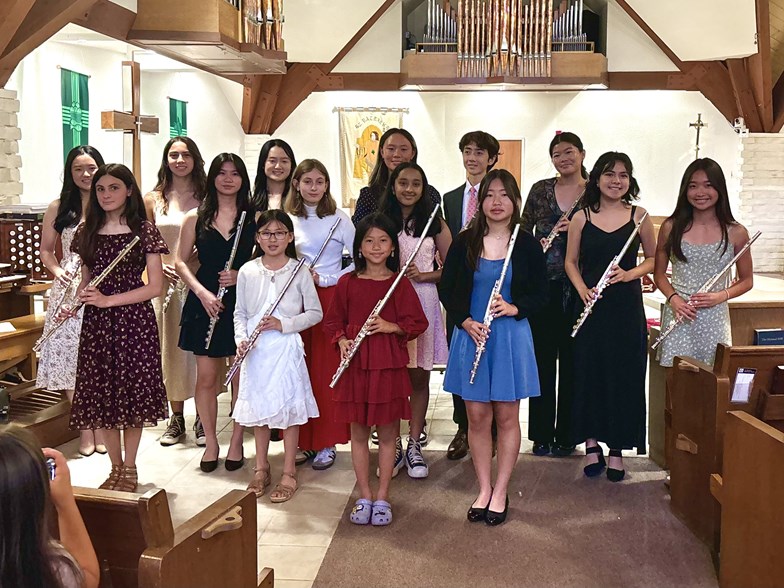Young flutists will usually play two flutes in their musical life- a beginner flute and an intermediate flute.
Beginner Flutes
Most flutists start with a beginner flute. This flute is best suited to help a beginner produce a strong tone in the first two octaves. Because rental prices are relatively low, and the commitment to flute in a long-term relationship is precarious at the beginning, most flutists rent a beginner flute in lieu of purchasing one. My favorite beginner flute is the Yamaha Student Flute Model 222.
Examples of other recommended beginner flutes include:
Pearl Student Series Flute Model 202
When renting a flute from a local music store, please request a Yamaha flute, as most offer this brand.
Intermediate Flutes
After a few years of flute playing, or when your flute teacher recommends it, you may want to upgrade to an intermediate flute. This flute will help in the next step of your playing. The head joint is designed with more detail, the flute will be made of purer metals, and the construction will include some extra key(s) and bells and whistles. The intermediate will help the flutist:
- Produce a richer tone, more tone colors, dynamics, and articulation
- Refine hand position, allowing for faster and more efficient technique
- Reach higher, third octave notes
- Improve the intonation among the instrument’s notes
Although there are rental intermediate flutes available at most music stores, most flutists choose to purchase their intermediate flute. This is usually the last flute most flutists will ever need/want. Prices for an intermediate flute range from about $1,400 to $3,500.
In a nutshell, we would trial about 3-6 flutes with the following characteristics:
- Open Holed
- Offset G
- B Foot with a Gizmo Key
And consider some some of the optional upgrades found below:
Materials:
- Silver-plated
- Solid silver .925 sterling silver
- Other metals (like gold) for lip plate riser body, springs
Additional options:
- Split E
- C# trill key
- D# roller
- Specific head joint ‘cuts’ (which produces a better tone)
Examples of intermediate flutes I recommend:
The Di Zhao Flute Model 400/501
Yamaha Intermediate Flute Model 362
Yamaha Intermediate Flute Model 462
Trevor James Virtuoso Model
Trevor James Chanson Model
Sonare By Powell Model 505
Burkart Resona Flute Model R100
The Di Zhao Flute Model 600/701
Amadeus By Haynes Model 680
Azumi By Altus Model AZ-1
Professional/Handmade Flutes
For the advanced high school flutist, or for the flutist wishing to minor or major in music at the college level, your teacher may recommend a professional, handmade flute. The process of purchasing a professional flute differs, depending on your budget, which starts around $5,000 and increases endlessly from there!

Common Topics:
Why buying a “really really inexpensive” flute on Amazon/online/etc. is not a great idea
I’m a huge fan of getting a good deal. I comparison shop and do research on everything. But I’ve found that there are some areas that a super deal isn’t to be found. Flutes are one of these purchases. Most flutes available for under $200 online are constructed in a way that precludes the ability to make any of the necessary adjustments and maintenance every flute will need. In other words, if your flute needs a tiny adjustment (that either your flute teacher or a music store can handle within minutes), the cheap flute is rendered unfixable and unplayable. It’s like scrapping a car when the first oil change is needed.
And what should be obvious, brightly-colored instruments all fit into this category.
Reputable flutes are worth the investment.
Purchasing a Used Flute
Overall, purchasing a used flute is risky. If you find a local seller, make sure the flute is from a reputable brand (referenced above) AND the seller allows you to take the flute to a music store with a repair technician to ensure it is in good playing condition.
Buying a used flute online (from eBay or similar) is even riskier, as it is more or less impossible to tell from photos if a flute is in good, playable condition. Additionally, issues like metal pitting can be difficult to see in photos online.
In conclusion, there have been more times than I’d like to count where a parent has bought a used flute at a great price, only to learn that the flute needs maintenance and repairs that would cost more than a new instrument. The used flute is rendered completely unusable, and the parent then realizes the time and money wasted.
Buying a used flute online from a reputable seller, like fluteworld.com, flutecenter.com, or flutacious.com, is the only way I recommend purchasing a used flute.
